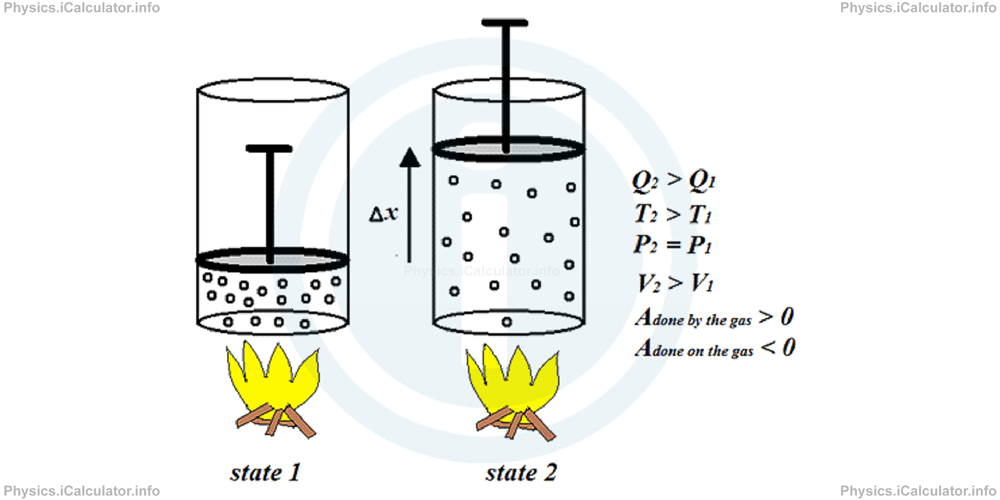Menu
Physics Lesson 13.5.4 - Work Done on a System and Work Done by a System
Please provide a rating, it takes seconds and helps us to keep this resource free for all to use
Welcome to our Physics lesson on Work Done on a System and Work Done by a System, this is the fourth lesson of our suite of physics lessons covering the topic of The First Law of Thermodynamics, you can find links to the other lessons within this tutorial and access additional physics learning resources below this lesson.
Work Done on a System and Work Done by a System
If the piston moves up or down, there is some work done, as the piston has a certain weight, which is equal to the minimum force needed to make it move. (It is known that Work = Force × Displacement).
Although work is a scalar quantity (no direction involved), in this topic it is appropriate to assign a direction to it, in order to understand what is happening to the gas inside the cylinder.
Let's consider a gas in a frictionless cylinder-piston system being slowly heated. The increase in temperature causes the piston to move up slowly, while the pressure remains constant. The gas is expanding against external forces, which are the weight of the piston and the force caused by atmospheric pressure.

Since the process is slow, we can write
When the piston is displaced by Δx, we have
or
Thus, we can write:
when the gas is expanding, Wdone by the gas is positive and Wdone on the gas is negative
when the gas is contracting, Wdone by the gas is negative and Wdone on the gas is positive
You have reached the end of Physics lesson 13.5.4 Work Done on a System and Work Done by a System. There are 6 lessons in this physics tutorial covering The First Law of Thermodynamics, you can access all the lessons from this tutorial below.
More The First Law of Thermodynamics Lessons and Learning Resources
Whats next?
Enjoy the "Work Done on a System and Work Done by a System" physics lesson? People who liked the "The First Law of Thermodynamics lesson found the following resources useful:
- Work Feedback. Helps other - Leave a rating for this work (see below)
- Thermodynamics Physics tutorial: The First Law of Thermodynamics. Read the The First Law of Thermodynamics physics tutorial and build your physics knowledge of Thermodynamics
- Thermodynamics Revision Notes: The First Law of Thermodynamics. Print the notes so you can revise the key points covered in the physics tutorial for The First Law of Thermodynamics
- Thermodynamics Practice Questions: The First Law of Thermodynamics. Test and improve your knowledge of The First Law of Thermodynamics with example questins and answers
- Check your calculations for Thermodynamics questions with our excellent Thermodynamics calculators which contain full equations and calculations clearly displayed line by line. See the Thermodynamics Calculators by iCalculator™ below.
- Continuing learning thermodynamics - read our next physics tutorial: The Kinetic Theory of Gases. Ideal Gases
Help others Learning Physics just like you
Please provide a rating, it takes seconds and helps us to keep this resource free for all to use
We hope you found this Physics lesson "The First Law of Thermodynamics" useful. If you did it would be great if you could spare the time to rate this physics lesson (simply click on the number of stars that match your assessment of this physics learning aide) and/or share on social media, this helps us identify popular tutorials and calculators and expand our free learning resources to support our users around the world have free access to expand their knowledge of physics and other disciplines.
Thermodynamics Calculators by iCalculator™
- Carnot Engine Efficiency Calculator
- Entropy Calculator
- Gas Laws Calculator
- Molecular Mean Free Path Calculator
- Translational Kinetic Energy Of Gas Calculator
- Root Mean Square Speed Calculator
- Ideal Gas Law Calculator
- Change In The Gas Internal Energy Calculator
- Radiative Heat Transfer Calculator
- Evaporative Heat Transfer Calculator
- Convective Heat Transfer Calculator
- Conductive Heat Transfer Calculator
- Final Temperature Of Mixture Calculator
- Heat Absorbed Or Released Calculator
- Thermal Expansion Calculator
- Temperature Calculator